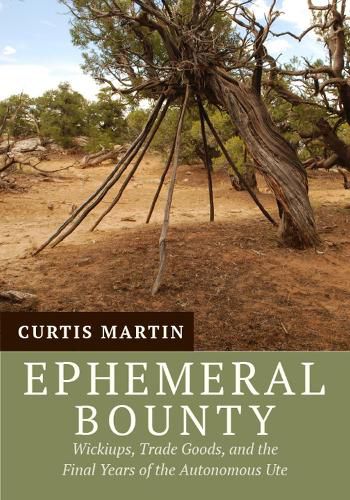Readings Newsletter
Become a Readings Member to make your shopping experience even easier.
Sign in or sign up for free!
You’re not far away from qualifying for FREE standard shipping within Australia
You’ve qualified for FREE standard shipping within Australia
The cart is loading…






The study of the last remaining Ute wickiups, or brush shelters, along with the historic artifacts found with them has revealed an understudied chapter of Native American history-the early years of contact with European invaders and the final years of Ute sovereignty. Ephemeral Bounty is the result of this archaeological research and its findings on the protohistoric and early historic Ute Indians of Colorado.
The Colorado Wickiup Project is documenting ephemeral wooden features such as wickiups, tree-platforms, and brush horse corrals that remain scattered throughout the mesas, canyons, and mountains of the state. They date from the arrival of European newcomers.
The project is unique in using the techniques of metal detection, historic trade ware analysis, and tree-ring dating of metal ax-cut wickiup poles to distinguish the Ute sites from historic Euro-American ones. Researchers have demonstrated that not all Utes left Colorado for the reservations in Utah during the final removal in 1881, as has been generally believed. A significant number remained on their homelands well into the early decades of the twentieth century, with new tools and weapons, but building brush shelters and living much as they had for generations.
$9.00 standard shipping within Australia
FREE standard shipping within Australia for orders over $100.00
Express & International shipping calculated at checkout
The study of the last remaining Ute wickiups, or brush shelters, along with the historic artifacts found with them has revealed an understudied chapter of Native American history-the early years of contact with European invaders and the final years of Ute sovereignty. Ephemeral Bounty is the result of this archaeological research and its findings on the protohistoric and early historic Ute Indians of Colorado.
The Colorado Wickiup Project is documenting ephemeral wooden features such as wickiups, tree-platforms, and brush horse corrals that remain scattered throughout the mesas, canyons, and mountains of the state. They date from the arrival of European newcomers.
The project is unique in using the techniques of metal detection, historic trade ware analysis, and tree-ring dating of metal ax-cut wickiup poles to distinguish the Ute sites from historic Euro-American ones. Researchers have demonstrated that not all Utes left Colorado for the reservations in Utah during the final removal in 1881, as has been generally believed. A significant number remained on their homelands well into the early decades of the twentieth century, with new tools and weapons, but building brush shelters and living much as they had for generations.